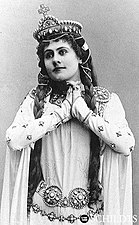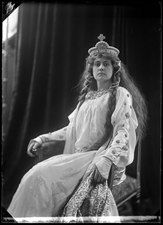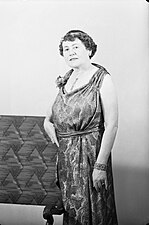| Aino Ackté | |
|---|---|
 Aino Ackté (c. 1900) Aino Ackté (c. 1900) | |
| Born | Aino Achte (1876-04-23)23 April 1876 Helsinki, Grand Duchy of Finland, Russian Empire (now Finland) |
| Died | 8 August 1944(1944-08-08) (aged 68) Nummela, Finland |
| Nationality | Finnish |
| Occupation | Opera singer |
| Signature | |

Problems playing this file? See media help.
Aino Ackté (originally Achte; 24 April 1876 – 8 August 1944) was a Finnish dramatic soprano. She was the first international star of the Finnish opera scene after Alma Fohström, and a groundbreaker for the domestic field.
Biography

Ackté was born in Helsinki. Her parents were mezzo-soprano Emmy Achté (née Strömer) and the conductor-composer Lorenz Nikolai Achté.
The young Ackté studied singing under her mother's tutelage until 1894 when she entered the Paris Conservatory, studying under Edmond Duvernoy and Alfred Girodet. Her debut at the Paris Opera was in 1897 in Faust and she was signed on for six years as a result. Ackté's coterie included among others Albert Edelfelt, who painted two famous full portraits of her in 1901 and 1902.

Aino Ackté married a lawyer, Heikki Renvall, in 1901 and gave birth to a daughter, Glory, the same year. She officially adopted the surname Ackté-Renvall. Their son, Mies Reenkola, was born in 1908.
In 1904 Ackté was engaged by the New York Metropolitan Opera where she remained until 1906. She performed the title role of Richard Strauss's Salome at its local premieres in Leipzig (1907) and London (1910). The Covent Garden premiere was an enormous success and Strauss himself proclaimed Ackté the "one and only Salome". Ackté considered the London performances her real breakthrough.
In 1911, Ackté, Oskar Merikanto, and Edvard Fazer founded the Kotimainen Ooppera (renamed in 1914 Finnish Opera, and then in 1956 the Finnish National Opera). She was to act as its director in 1938–1939.
After parting ways with the National Opera, Ackté organized an international Savonlinna Opera Festival beginning on 3 July 1912; it was held 1912–1914, 1916 and 1930.
Jean Sibelius dedicated his tone poem Luonnotar to Ackté and she premiered the work on 10 September 1913 at the Three Choirs Festival in Gloucester, England. She also sang in the first performance of Luonnotar in Finland, in January 1914.
Ackté ended her international travels in 1914 and returned to Finland, where she gave her farewell performance in 1920. She married Bruno Jalander, the governor of Uusimaa, in 1919, changing her name to Ackté-Jalander.
Her final public performances took place at the Savonlinna Opera Festival in 1930. She provided the libretto for Juha, and opera that received two treatments: the first by Aarre Merikanto (1922) and the second by Leevi Madetoja (1934). She died of pancreatic cancer in Nummela, Vihti in August 1944.
Legacy


She has a park road named after her, near the Olavinlinna in Savonlinna and another street in Helsinki, Finland. Her old summerhouse, Villa Aino Ackté [fi], located in Helsinki is being rented by the city for cultural activities and meetings.
Ackté is theorized to have most likely been the original model for the opera diva character Bianca Castafiore in comics books of "Adventures of Tintin" by Belgian Hergé.
Gallery
-
 In Wagner's Tannhäuser, 1899
In Wagner's Tannhäuser, 1899
-
 As Alcestis at Paris Opera in 1900
As Alcestis at Paris Opera in 1900
-
 In her outfit for Tosca, c. 1900
In her outfit for Tosca, c. 1900
-
 Photographed by Léopold-Émile Reutlinger in 1901
Photographed by Léopold-Émile Reutlinger in 1901
-
 As Elsa in Lohengrin, 1903
As Elsa in Lohengrin, 1903
-
 As Tosca in 1905
As Tosca in 1905
-
 As Salome, 1911
As Salome, 1911
-
 Ackté as Elsa, 1917
Ackté as Elsa, 1917
-
 Later in life in 1938
Later in life in 1938
References
- Severi Nygård: Tintti Suomessa (Tintin in Finland), Helsingin Sanomat, Kuukausiliite, October 2008.
- Macchi, Giuliano (1997). Musicus discologus: musiche e scritti per il 70. anno di Carlo Marinelli. Monteleone. pp. 219–228. ISBN 978-88-8027-029-4. Retrieved 10 October 2010.
- ^ Suhonen, Pekka (29 July 2016). "Ackté, Aino (1876 - 1944)". Kansallisbiografia. Archived from the original on 2017-08-05. Retrieved 25 June 2020.
- Lehtonen, Tiina-Maija (23 April 2019). "Oopperalaulaja Aino Ackté oli kiihkeä kuin Salome – Musiikin syntymäpäiväkalenteri". Yle. Archived from the original on 2019-04-23. Retrieved 25 June 2020.
- Kolsi, Eeva-Kaarina (4 September 2016). "Aino Ackté oli Suomen diivojen diiva – onnistui melkein säilyttämään siveän maineensa". Ilta-Sanomat. Retrieved 25 June 2020.
- Manninen, Antti (28 August 2005). "Aino Ackté oli 1900-luvun alussa kansainvälinen oopperadiiva". Helsingin Sanomat. Retrieved 25 June 2020.
- Estlander, Bernhard (1919). Elva årtionden ur Finlands historia ... (in Swedish). Söderström & c:o. p. 251. Retrieved 10 October 2010.
- Knaus, Gabriella Hanke (1999). Richard Strauss, Ernst von Schuch: ein Briefwechsel (in German). Henschel. p. 121. ISBN 978-3-89487-329-5. Retrieved 10 October 2010.
- Saarikivi, Sakari; Niilonen, Kerttu; Ekelund, Hilding (1955). Art in Finland. Kustannusosakeyhtiö Otava. p. 5. Retrieved 10 October 2010.
- Vainio-Kurtakko, Maria (2022). Ett gott parti : Scener ur Ellan de la Chapelles och Albert Edelfelts liv (in Swedish). Svenska litteratursällskapet i Finland. ISBN 978-951-583-557-4.
- Ekberg, Henrik; Rehnström, Vivi-Ann (1983). Uppslagsverket Finland (in Swedish). Schildts. p. 232. ISBN 978-951-50-0296-9. Retrieved 10 October 2010.
- Ekberg, Henrik; Rehnström, Vivi-Ann (1983). Uppslagsverket Finland 2 K-R (in Swedish). Schildts. p. 618. ISBN 978-951-50-0296-9. Retrieved 10 October 2010.
- Brockway, Wallace; Weinstock, Herbert; Leslie, George Clark (1941). The opera: a history of its creation and performance: 1600-1941. Simon and Schuster. p. 422. Retrieved 10 October 2010.
- Mäkinen, Timo; Pajamo, Reijo (1979). Ihminen musiikin valtakentässä (in Finnish). Jyväskylän yliopisto. p. 219. ISBN 978-951-678-166-5. Retrieved 10 October 2010.
- Karl-Josef Kutsch; Leo Riemens (1975). Unvergängliche Stimmen (in German). Francke. p. 10. ISBN 978-3-7720-1145-0.
- Symington, Andy (1 April 2009). Lonely Planet Finland. Lonely Planet. p. 136. ISBN 978-1-74104-771-4. Retrieved 10 October 2010.
- Goss, Glenda Dawn (2009). Sibelius: a composer's life and the awakening of Finland. University of Chicago Press. p. 357. ISBN 978-0-226-30477-9.
- Tett, Stuart (2016). Rea-Life Inspiration Behind TinTin's Adventures in King Ottokar's Sceptre. p. 15. Egmont UK Ltd.
External links
![]() Media related to Aino Ackté at Wikimedia Commons
Media related to Aino Ackté at Wikimedia Commons